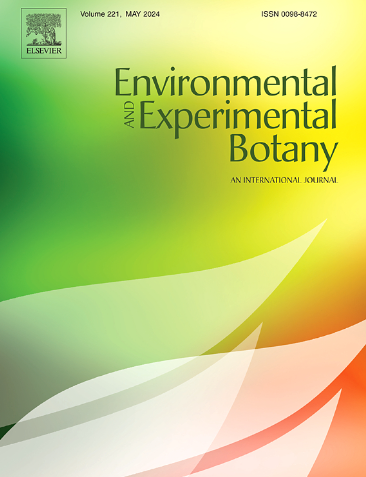Genome-wide identification of SnRK gene family and functional characterization of AcSnRK2.4 in response to heat stress in kiwifruit
IF 4.7
2区 生物学
Q2 ENVIRONMENTAL SCIENCES
引用次数: 0
Abstract
Sucrose non-fermenting 1-related protein kinases (SnRKs) are pivotal in the plant’s response to biotic and abiotic stresses, primarily by triggering protein phosphorylation cascades. Despite their significance, there is a paucity of information regarding SnRK genes within the kiwifruit (Actinidia chinensis). In this study, 51 AcSnRK genes were identified from kiwifruit genome and distributed on 23 chromosomes. Phylogenetic analysis showed that all AcSnRKs were classified into 3 subfamilies. The gene structure, conserved motif, gene duplications and cis-acting element in the promoter were accomplished using TBtools-II software. The publicly available transcriptome datasets and qRT-PCR analysis revealed that the majority of AcSnRKs were down-regulated by heat stress, with AcSnRK2.4 demonstrating a particularly pronounced reduction in expression. In addition, we explored the biological function of AcSnRKs2.4 using transient transformation methods. Overexpressed of AcSnRKs2.4 showed higher SPAD, but lower malondialdehyde (MDA) content, relative electrolyte leakage (EL) and ROS content compared with OE-EV lines under heat stress; while suppression of AcSnRKs2.4 showed a opposite result. Furthermore, OE-AcSnRK2.4 lines exhibited higher photosynthetic fluorescence parameters (except for Y(NO)), while these parameters were lower in pTRV-AcSnRK2.4 plants. These findings suggest that AcSnRK2.4 positively regulates kiwifruit's response to heat stress. Our findings offer a new insight into the potential function of AcSnRK2.4 in abiotic stresses and provide a theoretical groundwork for the molecular mechanisms underlying kiwifruit adaptation to such stress.
猕猴桃SnRK基因家族的全基因组鉴定及AcSnRK2.4对热胁迫的功能表征
蔗糖非发酵1相关蛋白激酶(SnRKs)在植物对生物和非生物胁迫的反应中起着关键作用,主要通过触发蛋白质磷酸化级联反应。尽管SnRK基因具有重要意义,但有关猕猴桃(Actinidia chinensis)中SnRK基因的信息却很少。本研究从猕猴桃基因组中鉴定出51个AcSnRK基因,分布在23条染色体上。系统发育分析表明,所有AcSnRKs可分为3个亚家族。使用TBtools-II软件完成基因结构、保守基序、基因复制和启动子中的顺式作用元件的分析。公开的转录组数据集和qRT-PCR分析显示,大多数AcSnRKs受到热应激的下调,其中AcSnRK2.4的表达降低尤为明显。此外,我们还利用瞬态转化方法探索了AcSnRKs2.4的生物学功能。与OE-EV相比,过表达的AcSnRKs2.4表现出较高的SPAD,但较低的丙二醛(MDA)含量、相对电解质泄漏(EL)和ROS含量;而AcSnRKs2.4的抑制结果则相反。此外,OE-AcSnRK2.4系的光合荧光参数较高(Y(NO)除外),而pTRV-AcSnRK2.4系的光合荧光参数较低。这些发现表明AcSnRK2.4正调控猕猴桃对热应激的反应。本研究为探究AcSnRK2.4在非生物胁迫中的潜在功能提供了新的视角,并为猕猴桃适应非生物胁迫的分子机制提供了理论基础。
本文章由计算机程序翻译,如有差异,请以英文原文为准。
求助全文
约1分钟内获得全文
求助全文
来源期刊

Environmental and Experimental Botany
环境科学-环境科学
CiteScore
9.30
自引率
5.30%
发文量
342
审稿时长
26 days
期刊介绍:
Environmental and Experimental Botany (EEB) publishes research papers on the physical, chemical, biological, molecular mechanisms and processes involved in the responses of plants to their environment.
In addition to research papers, the journal includes review articles. Submission is in agreement with the Editors-in-Chief.
The Journal also publishes special issues which are built by invited guest editors and are related to the main themes of EEB.
The areas covered by the Journal include:
(1) Responses of plants to heavy metals and pollutants
(2) Plant/water interactions (salinity, drought, flooding)
(3) Responses of plants to radiations ranging from UV-B to infrared
(4) Plant/atmosphere relations (ozone, CO2 , temperature)
(5) Global change impacts on plant ecophysiology
(6) Biotic interactions involving environmental factors.
 求助内容:
求助内容: 应助结果提醒方式:
应助结果提醒方式:


